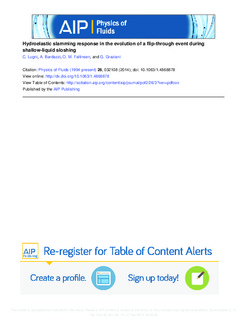| dc.description.abstract | The evolution of a flip-through event [6] upon a vertical, deformable wall during shallow-water sloshing in a 2D tank is analyzed, with specific focus on the role of hydroelasticity. An aluminium plate, whose dimensions are Froude-scaled in order to reproduce the first wet natural frequency associated with the typical structural panel of a Mark III containment system, is used. (Mark III Containment System is a membrane-type tank used in the Liquefied Natural Gas (LNG) carrier to contain the LNG. A typical structural panel is composed by two metallic membranes and two independent thermal insulation layers. The first membrane contains the LNG, the second one ensures redundancy in case of leakage.) Such a system is clamped to a fully rigid vertical wall of the tank at the vertical ends while being kept free on its lateral sides. Hence, in a 2D flow approximation the system can be suitably modelled, as a double-clamped Euler beam, with the Euler beam theory. The hydroelastic effects are assessed by cross-analyzing the experimental data based both on the images recorded by a fast camera, and on the strain measurements along the deformable panel and on the pressure measurements on the rigid wall below the elastic plate. The same experiments are also carried out by substituting the deformable plate with a fully stiff panel. The pressure transducers are mounted at the same positions of the strain gauges used for the deformable plate. The comparison between the results of rigid and elastic case allows to better define the role of hydroelasticity. The analysis has identified three different regimes characterizing the hydroelastic evolution: a quasi-static deformation of the beam (regime I) precedes a strongly hydroelastic behavior (regime II), for which the added mass effects are relevant; finally, the free-vibration phase (regime III) occurs. A hybrid method, combining numerical modelling and experimental data from the tests with fully rigid plate is proposed to examine the hydroelastic effects. Within this approach, the measurements provide the experimental loads acting on the rigid plate, while the numerical solution enables a more detailed analysis, by giving additional information not available from the experimental tests. More in detail, an Euler beam equation is used to model numerically the plate with the added-mass contribution estimated in time. In this way the resulting hybrid method accounts for the variation of the added mass associated with the instantaneous wetted length of the beam, estimated from the experimental images. Moreover, the forcing hydrodynamic load is prescribed by using the experimental pressure distribution measured in the rigid case. The experimental data for the elastic beam are compared with the numerical results of the hybrid model and with those of the standard methods used at the design stage. The comparison against the experimental data shows an overall satisfactory prediction of the hybrid model. The maximum peak pressure predicted by the standard methods agrees with the result of the hybrid model only when the added mass effect is considered. However, the standard methods are not able to properly estimate the temporal evolution of the plate deformation. | nb_NO |

